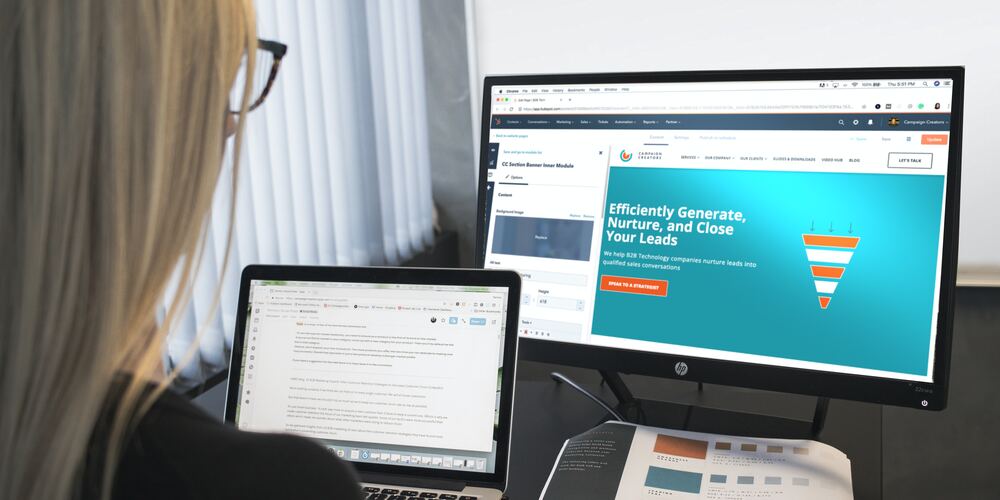It won’t be the golden goose of your marketing strategy (is that even a thing?). But ABM is a solid strategy for introducing more qualified leads to your brand and building a healthier and more sustainable pipeline.
We’ve discussed what ABM is and how it works in other blogs, but let’s get a quick recap before we dive into today’s content, which is all about implementation.
There are a few different ways to define ABM, but Kate Cygan, Director of Client Services, likes to explain it like this: “It’s a specific strategy combining very specific, intentional and timely activities to meet your target accounts where they are, when they’re there.”
ABM is all about targeting a specific audience and speaking directly to their unique pain points. It’s a personalized approach to capturing their attention and showing you can solve their problem.
For many people, however, the tricky part of ABM is putting it into practice. That’s why I tapped Krista Donohoe, MarTech Specialist, to walk us through implementing an ABM campaign in HubSpot. So open a new tab, log in to your portal and let’s get started!
Step 1: Planning
First and foremost, Krista recommends you figure out how long it will take you to create customized content for your ABM campaign. This might be time for writing a blog or email series, producing a video or creating a special landing page.
“You want to figure out what’s going to be your most effective use of time,” she says. “Find what can be done the fastest, works the best and gives you the highest return.”
Keep in mind that to find this perfect balance, you’ll have to go through some trial and error. Initially, focus on what you can reasonably accomplish without taking up too much time and as you run your campaign you’ll start to see what works best and generates leads.
Step 2: Use Your Data
The key to a successful ABM campaign is utilizing your customer data. HubSpot makes it easy to categorize contacts based on information like geographic location, lead source, business size and more.
For your first step, Krista recommends defining the details of your audience to as granular a level as you can. “From there, you can go through your portal and see what kind of data points you have in the system for your contacts. Ideally, those data points should match the criteria you came up with.”
With those data points, you can then pull together filtered lists to see which of your clients meet the ABM campaign criteria. If your first list doesn’t pull any contacts, don’t worry.
“If your initial criteria doesn’t pull anyone, then you can expand your search and cast a wider net. That way you still have a specific audience but you’re working with your portal to make finding ABM contacts a lot easier,” Krista says.
Step 3: Automate
Now that you have your content and your contacts, it’s time to start scheduling delivery. First and foremost, Krista reminds us that you should always use personalization tokens, since personalization is the cornerstone of an ABM campaign. Tokens help you effortlessly create custom content based on contact properties so you don’t have to go into each email or sales sequence and customize it yourself.
Now on to automation! Your email nurture series is the first part of your campaign that you should automate. HubSpot’s email marketing tool lets you schedule emails to send at designated intervals so you can start a campaign and then let it run itself. What’s better is you can set criteria to unenroll people from the campaign and convert the interaction to a one-on-one.
“When doing your initial reach out, you need to figure out what the qualification is for moving people out of the automation and into a one-on-one. This could be anyone who opened the email, clicked on your link, replied to your message, etc.”
This helps you to track and quickly respond to the contacts who are interested in moving forward.
Step 4: Follow Up
One of Kate’s biggest points for running an ABM campaign is to customize follow ups with prospects. It’s another crucial way to add personalization to your campaign and make the customer feel like you truly understand their pain points.
To help you speed up the customization process, Krista recommends these few HubSpot features:
- Custom landing pages with 1:1 videos
- Snippets with content that’s specific to that company’s industry and paint points. You can use these in custom emails or make the same copy into an email template.
- Personalized video messages in follow up emails
With content like this ready to go, you don’t have to waste time creating custom responses for leads. You can simply send a link, load a template or record a quick video and you’ve provided personalized service in half the time.
Step 5: Reporting
“It’s important to put together campaign reporting when you’re running an ABM campaign,” Krista says.
HubSpot’s campaign analytics tool provides insights into multiple areas of a single campaign, such as engagement, attribution and tracking. It’s a quick overview that helps you take a pulse on your campaign as it runs or do a review once it’s complete. The tool is available with Marketing Hub Professional and Enterprise.
“If you don’t have access to campaign analytics, then you can put together a custom dashboard to help you see the types of results. Make sure you’re tracking things like who opened emails, who scheduled meetings and how many deals have been created from your campaign.”
The more insights you can gain from your campaign reporting, the easier it will be to see what’s working and what’s not. This will help you hone your efforts so you spend your time on the highest return content, as Krista advised at the beginning of this post.
Tips for Your First ABM Campaign
If you’re new to ABM, then you might still feel a little unsure of the best way to start your first campaign. Krista’s advice: Start simple, start small.
“The first campaign is your test to get a baseline. It’ll help you find out if this approach works for your ideal customer, so you want to focus on figuring out what works before you go too deep.”
She adds that your first ABM campaign should be with a smaller segment of your target audience so you can focus most of your efforts on creating custom content. This campaign will help you get familiar with HubSpot’s customization and automation tools as well as the general flow of an ABM campaign. Use your reporting to see what worked best and then apply those practices in your next campaign.
As you get the hang of it, you’ll be able to slowly grow your efforts until you’re reaching the full list of target contacts you’d like to market to.
Always Be Marketing
ABM has been around for a while, but that’s because it works. When planned and implemented correctly, it’s a powerful tool for bringing a specific audience into your business through personalized marketing.
Once you move those contacts from the “lead” to “client” folder, you want to keep the positive momentum going. Check out our blog about providing personalized customer service to learn how.


